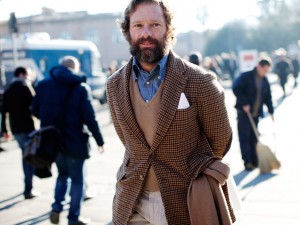My Grandfather’s Sense of Style
In the introductory post to Zero Sartorial, I mentioned my grandfather, David Barrington Edge. He was born in 1903, into a very different world from the one I know. He died in the summer of 1986, when I was 8 years old. My recollections of anything before 10 are pretty fuzzy these days, so it’s pretty likely that what I remember is more reconstruction than real memory. But that doesn’t make it any less of an influence, and it might make it more.
The main thing that I remember is that he wore a suit all the time. Dense, a rough surface, maybe a tweed. That’s almost certainly not actually accurate in technical terms, but it might not be far off. He wore matching trousers and jacket over a sweater, a light shirt and a string vest, and used braces (“suspenders”, for the American audience – those are something different here) as well as a belt. He wore shoes almost all the time, and argyle socks. He smoked a pipe, I know, and probably the occasional cigarette, as most adults did at the time. He often had a faint scent of soap about him; old-fashioned no-scent-but-the-soap soap.
I don’t actually know if he had more than one suit; presumably he did, but they must have been nigh-on identical. I do know he wore a “better suit” to church and to family occasions. I was never able to tell the difference between them. In very hot weather, or if he was doing heavy work – he did some fairly intensive vegetable gardening until only a year or two before he died – he’d take off the jacket, and work in his shirt sleeves, rolled well up. The sweater would have been left behind, but he’d still have the jacket until then. I have a clear memory of a spade standing with his jacket draped over it while he used a fork. He had Wellington boots for gardening, olive green, and would change them in the back porch before he went out.
The influence is twofold here. First, he’s the mental image I get when anyone says “suit”, it’s the default memory. So “suit” doesn’t really mean business to me, it means “Grandad”. I think I resisted wearing suits through my early 20s in part because of that; I didn’t want to be that grown-up. Second, he was one of the very few people I knew who actually dressed differently. In the early 80s in rural Ireland, few enough adults wore suits – only the old men, and the bank manager, and the solicitors, of which there were only a couple in any given town. Office jobs didn’t really exist. Farmers wore old, patched suit trousers, alright, but they wouldn’t have the jacket, and besides, when the garment was a Frankensteinian product of two or three fabrics, it was hard to think of it as a suit element at all. Corduroys were fairly ordinary, and jeans were starting to appear, though mostly among young people; the kind who also wore leather jackets. Slightly disreputable.
So there’s a degree to which suits appear to me to be old-fashioned. Not as in out of date, more as in comfortable, established, and maybe a bit on the un-modern naïve side. It is, in short, hard for me to take technical advice from someone wearing a tie.
But as I get a bit older (yes, yes, I know, mid-thirties whippersnapper) I begin to recognise that the clothes he wore were comfortable, and very well suited to his environment. He had multiple layers of solid fabric, which were a good practice in houses that had no central heating. He wore a vest so his shirt wouldn’t stick to him on hot days. He had plenty of pockets, at least one of which was big enough to accommodate a folded-over newspaper. His shoes were carefully chosen to be good for multiple purposes, and to last a long time, and he polished them frequently. He mended his Wellingtons with rubber patches, too. The braces meant his belt was never uncomfortable.
More and more, glancing at myself in the mirror, I see elements of him, in stance as well as in dress. And when I’m digging a new vegetable bed, I sometimes look up, and I really do expect to see a jacket hanging on the standing spade.
